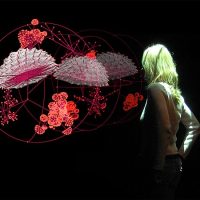16. March, 2005.
9.30 Inaguration: Július Gyula (Millenáris Kht.) and Nina Czeglédy (Leonardo/Olats)
9.50 Annick Bureaud (Leonardo/Olats): Space Art in the Activity of Leonardo
10.05 Arthur Woods (artist, Chair of OURS Foundation): History of Space Art
10.35 Almár Iván (astronomist, MTA): Relations of Society and Space
11.15 Peternák Miklós (Director, C3): Art and Science Relations viewed through Activities of C3
11.35 David Raitt (Senior Technology Transfer Officer, European Space Agency): Cultural and Artistic Events in Space: ESA’s Perspectives
11.55 Ariane Maugery(artist): Microgavity Oddity
12.15 Tsutomu Yamanaka (artist): Connecting Space Programs and Human Society by Space Renshi
12.35 Nina Czegledy: The Aurora Borealis
12.50 Discussion
17.30 Exhibition opening (Miklos Peternak, Jörg Lindenmaier)
18.30 Roger Malina: Keynote presentation
19.30 Video screening
The exhibition features media art installations as well as works dealing with the relation of space and society.
Mirror Space by Brigitta Zics is an interactive networked installation, which projects a personal, virtual mirror-image onto the screen, with the aid of the combination of the face of the visitor and data collected simultaneously from the Internet. This image behaves like the physical presence of a real mirror-image: it changes its position, dimensions and features according to the movement of the viewer. The common mirror-representations of individual visitors also interact with each other, and their audiovisual representation is perceivable as within the “mirror-space”. The “mirror-image” is active and alterable as long as the visitor remains in the data-space of the installation. When the visitor departs, the image, as her/his “impression”, remains and continues to move together with other representations. The mirror-images of the previous viewers disappear finally when the images of new visitors appear on the screen. (http://www.zics.net/mirror_space)
Environmash by Adrián Kupcsik and Júlia Vécsei is an interactive installation based on the functioning of the sound-mixer; here, however, it is not primarily sound tracks that float into each other, but visual motifs, accompanied by sounds suited to them. The elements of various locations and spaces — i.e., space, land, nature, city and abstract motifs ? appear as the analogy to musical composition. Within each composition, each sound track is represented by a separate visual element, so that in the case of the landscape, e.g., there are trees, bushes, flowers and clouds; in the urban composition, there are buildings, cars, parks, etc. When the visitor changes an element, the environment is changed accordingly, as is its “tone”.
